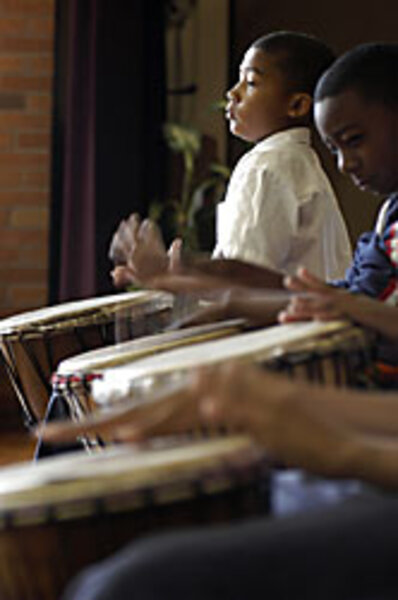Waiting may be hard, but it's filled with possibilities
Loading...
Waiting is the hardest part. I never realized that playing a musical instrument is as much about not making noise as about making noise – about not blowing your trumpet, not plucking the bass string, not hitting the drum. But learning to play solo or in unison, with syncopation or without, turns out to be a special kind of wait training. It is learning to put silences between sounds, and that is what makes the sounds so special.
I wouldn't have thought of this if an African drummer named Kevin Campbell hadn't come to the school at which I'm principal. When he was talking with the fifth-graders about the interstices between their hits on the djembe and conga drums, he used an interesting phrase: "Don't rush the spaces."
Since nature apparently "abhors a vacuum," it's hard not to rush in to fill spaces. As I thought about it, however, I realized that spaces in time and distance aren't necessarily empty. They are full of purpose. They contain silence, longing, anticipation – or room. Spaces hold something even when we see or hear nothing inside them.
Kevin's phrase caused me to start considering the number of temptations I experience in any given day to "rush the spaces" between "notes" of all kinds – and lots of things qualify as notes! Even simple, casual observation is a valuable skill and can't take place with depth and mindfulness if it is rushed.
For example, the kids at my school had been watching the monarch butterfly chrysalises in our dooryard. Should we think in terms of the "space" between caterpillar and winged insect? Or perhaps the space that the newly hatched butterfly takes to let its wings dry in preparation for flight? What does it think so as not to rush that space? And then as soon as it takes flight, it's got to rush the space – from here to Mexico!
In art class, when our students go out to draw the neighborhood buildings from a certain perspective, they are accustomed to not rushing the negative spaces. They discover that what's not told by their pencil lines or paint splotches is every bit as important as what is filled in on their paper.
The same can be said of narrative technique in writing. Any mystery writer knows that the mere mention of a door, or perhaps an old seaman's chest locked shut – having been recently discovered in, say, a dark recess of the attic of the derelict hardware store – is a tempting or even deliciously horrifying lack of description. Don't rush the spaces between words – and don't open that door ... just yet!
Baseball's 60 feet, 6 inches of space between the pitcher's mound and the batter's box is one of the most sublime stretches of anticipation and longing in the known universe. The ballpark crowd certainly abhors a vacuum: "Swing batter!" Or, "No, don't swing!"
An instant's decision about timing and rhythm and space creates the grand-slam symphony or ignominious sour strikeout note. Don't rush the spaces between the curveball release and the swing of the bat.
A physicist might understand distances in time and space somewhat differently. Consider the interstellar voids we see in the night sky. And all that's observable by our eyes doesn't even add up to the quantum values for known matter. There must be something in the spaces that we don't yet understand. Spaces await description, definition, and scientific understanding. They contain dark matter, we conjecture, so we keep listening to the spaces filled with light-years.
So, waiting is anticipation, getting ready for that next beat, the next cadence, the next occasion to imitate Kevin on the djembe and echo his beguiling rhythms – or the opportunity to swing at whatever junk that lefty pitcher can muster, standing so confidently 60+ feet away. Waiting for that pitch can seem like a light-year.
Back at school, we are enjoying – not rushing – the spaces. We await the next time we'll get to sit in a circle and play the African drums. Until Kevin returns with his congas and djembes, a bunch of No. 10 cans, 5-gallon plastic buckets, and an old trash can will serve as the percussion section.
At recess, the students are rushing the space between 11:40 and noon – and between lunch and math class, too – as they take part in a glorious percussive chorus out behind the building.
Waiting may be the hardest part, but it's a space that's full of possibilities. As Milton wrote, "They also serve who only stand and wait."





